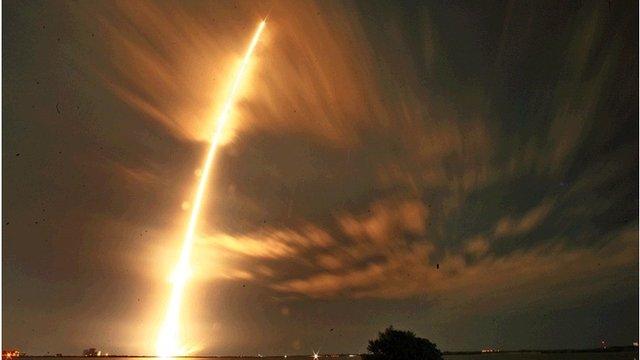SpaceX tests launch abort system
- Published
The demonstration took place at Cape Canaveral Air Force Station (footage courtesy of Nasa)
SpaceX has put its Dragon astronaut capsule through a practice abort.
The demonstration simulated what would happen to the crewship in the event of a rocket failure on the launch pad.
Wednesday's test was conducted at Cape Canaveral in Florida, and saw a test vehicle - carrying no humans, only a dummy - hurled skywards by a set of powerful in-built thrusters.
The Dragon ship was propelled to a safe distance, lowering itself softly into the Atlantic via three parachutes.
SpaceX expects to start launching astronauts in 2017.
It is one of two companies that have been contracted by the US space agency (Nasa) to develop vehicles to ferry people to and from the International Space Station (ISS). The other firm is Boeing.
Both have to demonstrate effective launch escape technologies for their rockets and capsules to receive certification. Only with the necessary assurance will Nasa permit its astronauts to climb aboard.
SpaceX has elected to use a so-called pusher system on the Dragon.
Eight SuperDraco thrusters have been integrated into the side of the ship, and these fired in tandem for just over five seconds at the start of the test to hurl the ship up and to the east of the Cape.
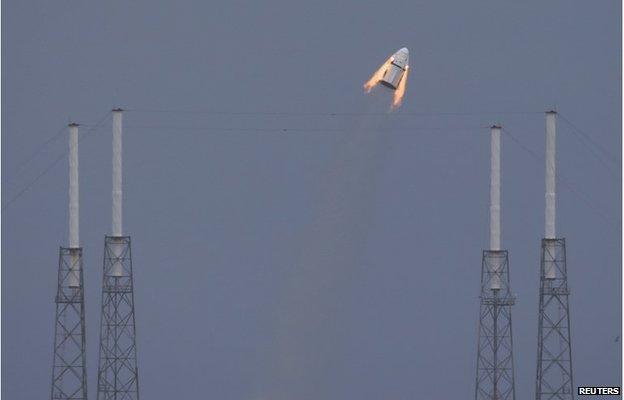
The test simulated what would happen to a crewed ship in the event of a rocket failure
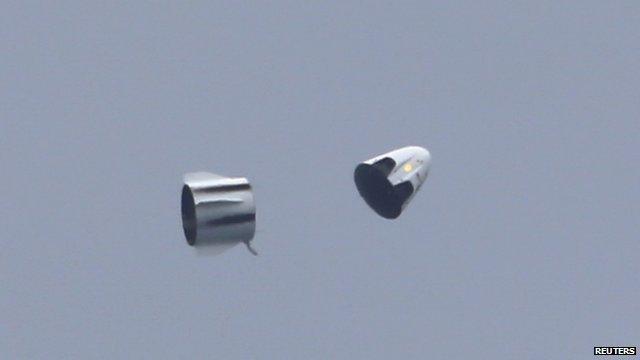
After dropping its "trunk", the vessel headed safely towards the ocean
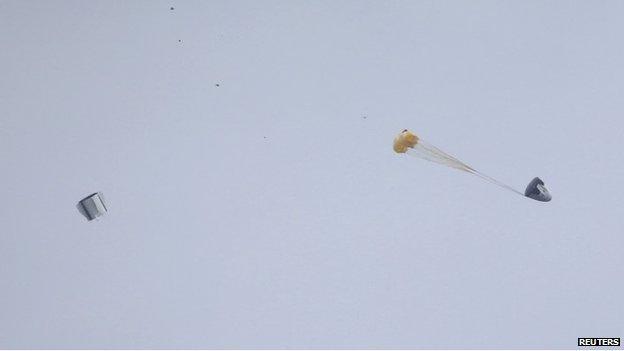
Dragon deployed two drogue chutes to stabilise its flight
Once the thrusters' burn was completed, the vessel continued to coast upwards for about 15 more seconds. It then dropped its trunk (a structural, aerodynamic collar), and headed downwards, deploying first a couple of drogue chutes to stabilise itself, before putting out three main canopies to make the ocean splashdown.
From beginning to end, the flight lasted just under 100 seconds, with the Dragon travelling just off-shore. And although the early indications are that the Dragon might not have achieved quite the velocities anticipated, it certainly stepped through all of its flight phases successfully.
The capsule's only passenger was a dummy, but engineers will be able to describe the experience humans would have had from all the sensor data that was gathered.
One consequence would have been high g-forces - several times the acceleration due to gravity. Tough, but something for which astronauts are well trained.
Traditionally, abort systems have used a tower placed atop the capsule to pull it clear in the event of a rocket failure.
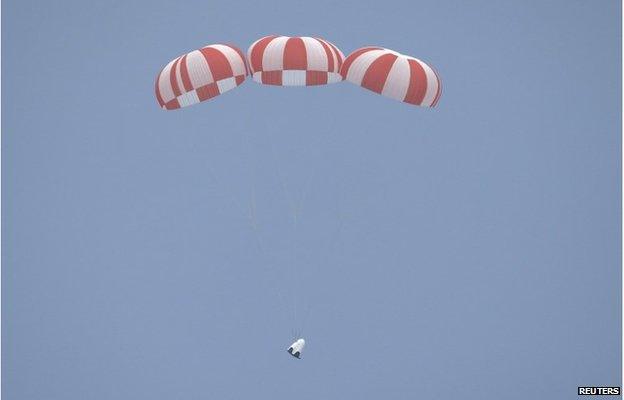
Three main chutes then opened to bring Dragon down to the water's surface

The American Mercury and Apollo programmes used this arrangement, as do the current Russian Soyuz and Chinese Shenzhou spacecraft.
A downside of these "tractor" mechanisms is that they need to be detached prior to a capsule reaching orbit. A pusher system, on the other hand, because it is integrated into the vehicle itself, does not need to be ejected. This means it can provide an emergency separation throughout the rocket's entire ascent phase.
Boeing, too, has designed a pusher system into its forthcoming CST-100 capsule.

An Apollo-era pad abort test: The thrusters were placed above the capsule
"It's the more sophisticated, modern approach. And in my opinion it's also the safer approach to launch escape," Hans Koenigsmann, SpaceX's vice-president of mission assurance, told reporters before the test.
And Jon Cowart, from Nasa's commercial crew programme office, had added: "We see no inherent problem with doing it this way. It's innovative and that's really part of the whole reason we're doing commercial crew. Let's learn to do business a new way."
SpaceX has chosen the configuration also because it plans eventually to bring all Dragon capsules back to land at the end of a mission.
Instead of the parachute-assisted ocean splashdown, the craft will make a propulsive, precision return to a spaceport using their powerful in-built SuperDraco thrusters.
SpaceX intends to try an in-flight abort later in the year.
This would see the same procedure again but carried out a minute or two into the flight of one of the company's Falcon rockets.
It would tell engineers how well the system copes when it is pushing up against a wall of on-rushing air as the rocket heads to orbit.
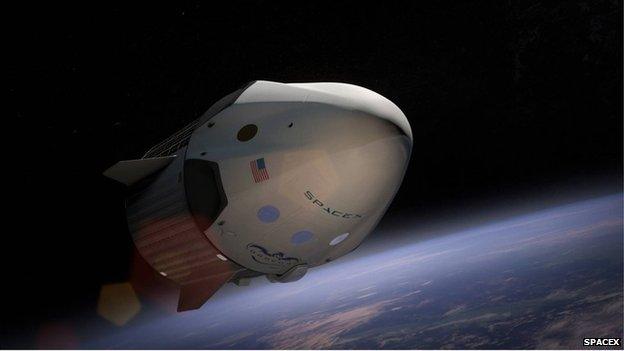
The crew capsule is an upgraded version of SpaceX's robot freighter, which resupplies the ISS
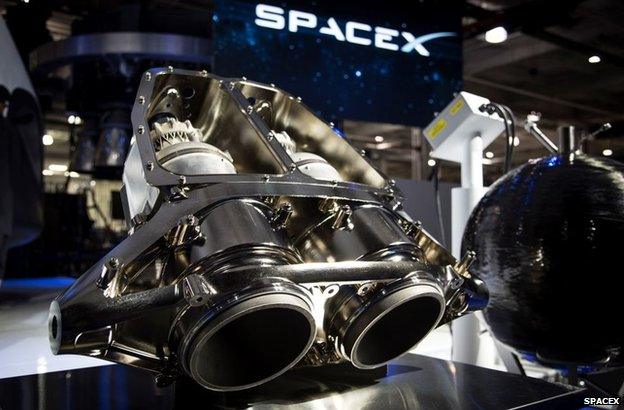
The 3D-printed SuperDraco thrusters will permit precision returns to land
Jonathan.Amos-INTERNET@bbc.co.uk, external and follow me on Twitter: @BBCAmos, external
- Published15 April 2015
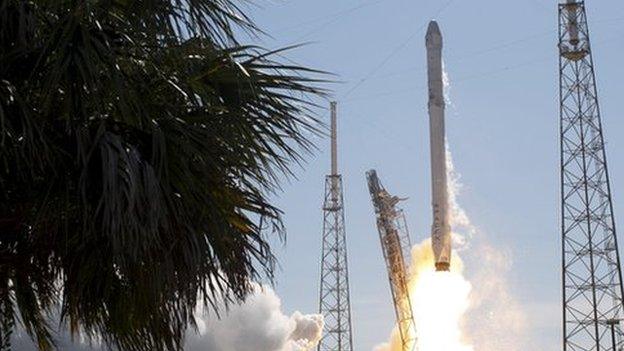
- Published18 January 2015

- Published10 January 2015
